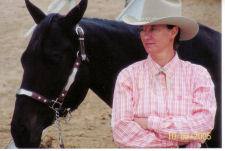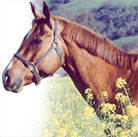| Article Archives
Starting
your own colt
Colt Starting
Quiz
Problem Horses,
part 1
Fear
Problems, part 2
Bad
Actors, part 3
The
Cold Backed Horse
Want
to Compete?
Bit Basics
Going
Places
Common
Sense, Horse Sense
Horsemen's
Christmas
Rainy Day
Training
Try Something
Different!
Green Broke
Resolution
Time
Going in
Circles
Hot Enough
for Ya?
Pleasure
or Equitation?
Return
to Work Carefully
Saving
your "Good Stuff"
Holding
Western Reins
Keep Your
Eyes on the Prize
Cold Weather
Warm Up
Expect
the Unexpected, 1
Expect
the Unexpected, 2
Bad Attitude
Horse of
a Better Color?
Power of
Exercise
Importance
of the Herd
Bath Time
Even Up
Choosing
a Martingale
Showmanship
A Good Night's Sleep
|
Alternative Therapies
and Horse Training
Part One
Doris Eraldi
Alternative therapies for horses such as massage, acupressure
and chiropractic have become so common in the past twenty
years that sometimes it’s hard to remember when we
didn’t recognize their power and usefulness. I distinctly
remember our first introduction to the benefits of equine
massage. John was starting a well-bred cutting filly, but
even though she was well-conformed and willing, she was only
couple of months into the training when we ran into a major
problem – the filly would not turn to the left correctly.
She would swivel her head instead of bending her neck, and
then throw herself around the turn shoulder first. After
trying about everything we could think of, John decided that
this filly, in spite of her great breeding and looks, just
wasn’t going to make it as a show cutting horse, and
he called the owner to tell him to come get her.
The filly’s owner was disappointed, but he also had
a suggestion. “Is it alright if I send someone up to
look at her? He does equine massage,” the owner asked.
We didn’t see any reason not to try it, but we did
not have much hope that a “miracle” would take
place.
The body-worker listened while we described the “training” problem
and then started palpating the filly’s neck. As he
worked on the little mare, massaging the muscles along her
top-line, the filly relaxed, heaved a few big sighs and lowered
her neck. Suddenly there was a loud POP. The mare opened
her eyes wide and looked around. “I think that might
have been the problem,” he said. He worked on her a
while longer, suggested we let her rest the remainder of
the day, and that we ride her lightly for the next day or
two, but even with a careful start back to work, it was obvious
that the “miracle” had indeed happened. The mare
not only could turn easily both directions, but she continued
on to be the high-selling horse at that fall’s Pacific
Coast Futurity Sale, and then to go on to a long and successful
career in the cutting pen. You can be sure that we were open
to alternative therapies, the next times we had a training
horse that “just wasn’t doing right.”
Several years later, I had the opportunity to participate
in clinics put on by Diana Thompson. Thompson specializes
in equine acupressure and massage, and I found many aspects
of her programs that could be directly used as a part of
the training program. Acupressure points can be used to calm
a horse and to relieve pain and tension that is a by-product
of even the most careful horsemanship. Training, especially
starting young horses, is not only mentally stressing, but
requires the horse to physically move in new ways. This often
causes aches or worse. Alternative therapies such as massage
and acupressure are not a replacement for veterinary care,
instead I use them along with traditional medical treatments.
If something is wrong with a horse, it is vital to know exactly
what it is (or isn’t) before starting on any course
of treatment. While many times I find it best to call in
a professional body-worker to help the horse, I’ve
found a few common problems which I can address myself with
massage or acupressure as part of the training process.
One of the most common problems for Pleasure
and Performance horses is tension and pain in the upper neck
(the first third of the neck behind the ears) that comes
from learning to carry their necks low and flex at the poll.
Many horses in training also have pain in the lower back
(lumbar and sacrum), and some also develop tension in the
ribcage and chest area that can lead to cinchiness. All of
these problems can be address early on with acupressure and/or
massage. The calming points are always helpful too. In next
month’s article, I’ll
share the three massage and acupressure techniques that I
use most often in the training process.
 Doris
Eraldi of Eraldi Training in Potter Valley, trains horses
and riders of all ages. She specializes in Pleasure,
Showmanship and Equitation events. She can be contacted
at 707-743-1337, or by e-mail dyan@eraldi.net. Doris
Eraldi of Eraldi Training in Potter Valley, trains horses
and riders of all ages. She specializes in Pleasure,
Showmanship and Equitation events. She can be contacted
at 707-743-1337, or by e-mail dyan@eraldi.net.
<< Back
to Rainbow Ag Horse Home Page |
